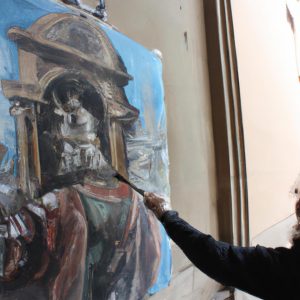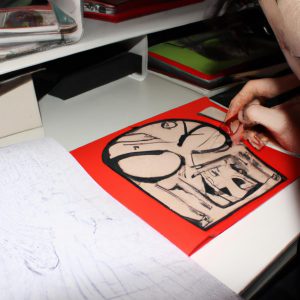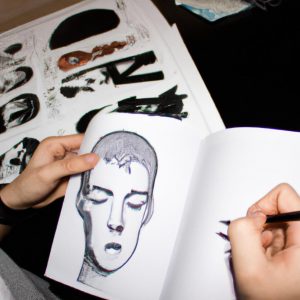Art Periods in Art History: The Intersection of Arts and Comics

Art history is a vast field that encompasses the study of various art periods, each characterized by distinct styles, techniques, and themes. These art periods not only reflect the evolution of artistic expression but also serve as windows into the socio-cultural contexts in which they emerged. This article explores the intersection between two seemingly disparate realms – fine arts and comics – to shed light on how different art periods have influenced and been influenced by this popular medium.
To better understand this dynamic relationship, let us consider an example: the impact of Impressionism on comic book illustrations during the late 19th century. The emergence of Impressionism revolutionized traditional notions of representation through its emphasis on capturing fleeting impressions of light and color rather than precise details. In turn, artists working within the realm of comics began experimenting with similar techniques, using vibrant colors and loose brushstrokes to evoke movement and atmosphere in their illustrations. This case study exemplifies how art movements can transcend disciplinary boundaries and inspire new forms of visual storytelling.
The exploration of art periods in relation to comics raises intriguing questions about the interplay between high and low culture, as well as the potential for cross-pollination among diverse artistic practices. By examining specific examples throughout history, we will delve deeper into this fascinating intersection and uncover the ways in which art periods have influenced the visual language and narrative strategies used in comics.
For instance, the geometric abstraction of the early 20th century, as seen in movements like Cubism and Futurism, challenged traditional notions of representation by breaking down forms into geometric shapes and depicting multiple viewpoints simultaneously. This innovative approach to visual composition found its way into comic book panels, with artists experimenting with fragmented perspectives and dynamic compositions to convey movement and energy.
Similarly, the surrealist movement, known for its exploration of dreams, subconscious desires, and unconventional imagery, had a profound impact on the world of comics. Surrealists sought to disrupt logical narratives and create unexpected juxtapositions in their artworks. This influence can be seen in various surreal or fantastical elements present in comics, as well as the use of dream-like sequences and symbolic imagery to convey deeper meanings.
The Pop Art movement of the 1950s and 1960s also left an indelible mark on comic book illustrations. With its focus on popular culture icons and consumerism, Pop Art celebrated mass-produced imagery and embraced bold colors and graphic styles. Comic book artists incorporated these elements into their work, creating visually striking images that reflected the vibrant pop culture landscape of their time.
These examples demonstrate how art periods have not only influenced comic book aesthetics but also expanded the possibilities for storytelling within this medium. By borrowing techniques from different artistic movements, comic book artists can create visually engaging narratives that resonate with contemporary audiences.
In conclusion, exploring the relationship between art periods and comics unveils a rich history of cross-pollination and innovation. From Impressionism to Cubism, Surrealism to Pop Art, each art period has left its imprint on this popular medium. The interplay between high culture art movements and low culture comics opens up new avenues for creativity while reflecting broader socio-cultural shifts. By examining specific examples throughout history, we gain a deeper appreciation for the ever-evolving nature of visual storytelling.
Prehistoric Art
In the early stages of human civilization, art emerged as a means of expression and communication. One fascinating example is the cave paintings found in Lascaux, France. These ancient artworks provide us with valuable insights into prehistoric communities and their way of life.
Emotional Bullet Points:
- The awe-inspiring beauty of these paintings transports us to a time long gone.
- They ignite our curiosity about the people who created them and their motivations.
- Through these artworks, we can connect on a primal level with our ancestors and their experiences.
- Their preservation allows us to appreciate the artistic skills that existed thousands of years ago.
| Lascaux Cave Paintings | |
|---|---|
| 1 | Depict various animals |
| 2 | Used natural pigments |
| 3 | Executed with remarkable precision |
| 4 | Reflect deep cultural significance |
The Lascaux cave paintings showcase not only the technical prowess but also the symbolic nature of prehistoric art. By skillfully utilizing natural pigments and displaying an impressive attention to detail, these artists depicted various animals such as horses, bison, and deer. This meticulous execution suggests a profound understanding of both anatomy and perspective.
Furthermore, it is important to note that these paintings were not merely decorative; they held significant cultural meaning for those who created them. They may have served as communal storytelling devices or even played a part in rituals and ceremonies within their respective societies. Consequently, exploring this form of art provides invaluable glimpses into the beliefs and practices prevalent during prehistoric times.
Transitioning seamlessly into Ancient Egyptian Art, we witness how artistic expressions evolved from primitive forms towards more structured representations that reflected societal values and religious beliefs without any noticeable gap between them.
Ancient Egyptian Art
Art Periods in Art History: The Intersection of Arts and Comics
Prehistoric Art has laid the foundation for artistic expressions throughout history. Now, let us delve into the captivating world of Ancient Egyptian Art. To better understand its significance, we will explore a hypothetical case study that highlights the unique characteristics of this period.
Imagine a grand temple adorned with intricate wall paintings depicting scenes from ancient religious rituals and daily life. These murals not only served as decorative elements but also conveyed symbolic meanings to communicate with divine entities. One such example is the tomb painting known as “The Judgment Scene,” where Osiris presides over the weighing of the deceased’s heart against Ma’at’s feather, determining their fate in the afterlife.
Ancient Egyptian Art can be characterized by several key features:
- Symbolism: Artists used symbols and hieroglyphics to convey meaning and tell stories.
- Formality: Works were often executed with precision and adhered to strict rules of composition.
- Profile Perspective: Figures were typically depicted in a profile view, emphasizing clarity rather than naturalistic representation.
- Hierarchical Scale: Important figures were portrayed larger than others, reflecting their elevated status within society.
To further illustrate these characteristics, consider the following table:
| Symbolism | Formality | Profile Perspective | Hierarchical Scale |
|---|---|---|---|
| Ankh (symbolizing eternal life) | Symmetrical compositions | Profiles views of pharaohs | Pharaoh depicted larger than servants |
| Scarab beetle (representing rebirth) | Clear outlines | Depiction of deities | Gods shown larger than humans |
| Lotus flower (associated with creation) | Precise use of colors | Portrayal of animals | Higher-ranking officials depicted larger |
Through these distinct qualities, Ancient Egyptian Art invites viewers to dive into an enchanting realm where mythology intertwines with everyday life. As we transition to the next section on Classical Greek Art, we will explore how this period diverged from Egyptian traditions while forging its own artistic path.
Next section: Classical Greek Art
Classical Greek Art
Art Periods in Art History: The Intersection of Arts and Comics
Ancient Egyptian Art focused on portraying the divinity of pharaohs and their connection to the afterlife. Now, let us delve into Classical Greek Art, a period that emerged around 600 BCE and lasted until approximately 323 BCE. To illustrate the impact of this art movement, consider a hypothetical scenario where an ancient Greek sculptor is commissioned to create a statue for a prominent city-state.
Classical Greek Art was characterized by its idealized representations of human figures, reflecting the belief in the harmony between physical beauty and moral virtue. In this hypothetical case study, our sculptor would employ meticulous attention to detail while capturing the grace and poise of the subject. This example showcases how classical Greek artists sought to communicate not only aesthetic qualities but also deeper philosophical concepts through their work.
To evoke an emotional response in viewers, we can highlight four key aspects of Classical Greek Art:
- Balance: The use of contrapposto, where weight is shifted onto one leg while the other remains relaxed, creates a sense of equilibrium.
- Proportion: Artists adhered to strict mathematical ratios when depicting figures, aiming for perfect symmetries.
- Expression: Facial features were often serene or neutral, conveying ideals such as wisdom or courage.
- Narrative: Sculptures frequently depicted mythological scenes or historical events to engage audiences intellectually and emotionally.
Moreover, we can further explore these characteristics by examining them within a three-column table:
| Aspect | Description | Example |
|---|---|---|
| Balance | Contrapposto technique used; weight shift evident | Statue of Discobolus |
| Proportion | Figures adhere to mathematical ratios | Statue of Doryphoros |
| Expression | Serene or neutral facial expressions | Hermes with Infant Dionysus |
| Narrative | Mythological or historical scenes depicted | Parthenon frieze depicting the Panathenaic procession |
In conclusion, Classical Greek Art represents a pivotal period in art history marked by its emphasis on idealized human forms and philosophical expression. By employing intricate techniques such as contrapposto and adhering to mathematical proportions, artists sought to evoke emotional responses from viewers while conveying deeper narratives. This artistic tradition laid the foundation for subsequent movements, including Renaissance Art.
Next, we will explore Renaissance Art, an era of rebirth and innovation that emerged in Italy during the 14th century.
Renaissance Art
Classical Greek Art, with its emphasis on idealized forms and the celebration of human anatomy, laid the foundation for artistic representation for centuries to come. As we move forward in art history, let us explore the transformative period known as the Renaissance.
Imagine a world where creativity flourished alongside scientific advancements, resulting in an explosion of artistic expression. During the Renaissance, artists sought inspiration from classical antiquity while also embracing new techniques and perspectives. One notable example is Leonardo da Vinci’s “Mona Lisa,” which captures not only a realistic portrayal of a woman but also conveys her enigmatic presence through subtle details like the mysterious smile.
To better understand this fascinating era, let us delve into some key aspects that defined Renaissance art:
- Humanism: The Renaissance marked a shift towards human-centric themes, celebrating individual achievements and exploring emotions and experiences.
- Perspective: Artists mastered linear perspective to create depth and realism within their works, allowing viewers to immerse themselves in lifelike environments.
- Naturalism: Emulating Classical Greek ideals of beauty, Renaissance artists focused on representing figures realistically by studying human anatomy and proportions.
- Patronage: Wealthy individuals such as the Medici family played a crucial role in supporting artists during this time, commissioning grand artworks that showcased their prestige and power.
These elements can be further understood through the following table:
| Aspect | Description | Example |
|---|---|---|
| Humanism | Emphasis on human potential and achievements | Michelangelo’s “David” |
| Perspective | Technique used to create an illusion of depth on a two-dimensional surface | Masaccio’s “The Holy Trinity” |
| Naturalism | Representation of figures based on careful observation of nature and study of human anatomy | Botticelli’s “The Birth of Venus” |
| Patronage | Financial support provided by wealthy individuals, allowing artists to create magnificent works of art that showcased their patrons’ wealth and influence | Raphael’s “The School of Athens” (commissioned by Pope Julius II) |
As we move forward into the next section on Impressionism, it is important to recognize how Renaissance art laid the groundwork for future artistic developments. The exploration of human emotions, mastery of perspective, and realistic representation became building blocks for new artistic movements that emerged in subsequent periods.
Transitioning seamlessly into our discussion on Impressionism, let us now explore an art style characterized by capturing fleeting moments and subjective experiences through vibrant brushwork and a focus on light and color.
Impressionism
Art Periods in Art History: The Intersection of Arts and Comics
Renaissance Art marked a significant shift in artistic expression, characterized by the revival of classical ideals and the exploration of perspective and human anatomy. However, this was just one chapter in the rich tapestry of art history. Moving forward, we delve into Impressionism, an art movement that emerged in the late 19th century.
To illustrate the impact of Impressionism on both traditional arts and comics, let us consider a hypothetical scenario where an artist from this period decided to experiment with comic panels to capture fleeting moments of everyday life. By employing loose brushstrokes and vibrant colors commonly associated with Impressionist paintings, this artist creates a series of comic strips depicting scenes from bustling Parisian streets or tranquil countryside landscapes. This fusion between impressionistic techniques and narrative storytelling breathes new life into comics as it invites viewers to immerse themselves in evocative visual experiences.
The influence of Impressionism extended beyond individual artworks; it also revolutionized how artists approached their craft. Here are four ways in which Impressionism left its mark on both traditional arts and comics:
- Emphasis on capturing light and atmosphere rather than precise details
- Exploration of unconventional subject matters, including ordinary people engaged in mundane activities
- A departure from strict academic conventions towards more expressive forms
- An increased focus on outdoor painting en plein air, embracing nature’s ever-changing qualities
In examining these aspects through a comparative lens, we can appreciate how Impressionism blurred the boundaries between fine art and sequential illustrations found within comics.
Impressionism paved the way for future movements such as Pop Art, which challenged conventional notions surrounding popular culture and mass media imagery. In our next section about “Pop Art,” we will explore how artists incorporated elements from advertising, consumer products, and comic book aesthetics to comment on contemporary society while continuing to push the boundaries of artistic expression.
Pop Art
Impressionism, with its focus on capturing the fleeting effects of light and color in a subjective manner, paved the way for new artistic movements that challenged traditional notions of representation. As we move forward in our exploration of art periods in art history, let us delve into Pop Art – an influential movement that emerged in the mid-20th century.
One example that exemplifies the essence of Pop Art is Andy Warhol’s iconic artwork “Campbell’s Soup Cans.” Created in 1962, this piece consists of thirty-two individual canvases depicting Campbell’s soup cans, each one representing a different flavor. By elevating mundane consumer objects to the status of high art, Warhol blurred the boundaries between popular culture and fine art.
Pop Art can be characterized by several key features:
- Emphasis on everyday consumer items: Artists often incorporated mass-produced objects such as food packaging, comic strips, or advertising imagery into their works.
- Use of bold colors and graphic techniques: Vibrant hues combined with strong outlines created visually striking compositions.
- Appropriation and collage: Artists borrowed images from popular media sources and recontextualized them within their artworks.
- Critique of consumer society: Through their work, Pop artists commented on themes related to mass production, commercialization, and celebrity culture.
To further illustrate these characteristics, consider the following table:
| Artist | Key Works | Influences |
|---|---|---|
| Andy Warhol | “Marilyn Diptych,” “Brillo Boxes” | Commercial illustration |
| Roy Lichtenstein | “Whaam!,” “Drowning Girl” | Comic books |
| Claes Oldenburg | “Giant Three-Way Plug” | Surrealism |
| Richard Hamilton | “Just What Is It That Makes Today’s Homes So Different?” | Consumer culture |
The emergence of Pop Art challenged the traditional boundaries between high and low culture, provoking both admiration and criticism. This movement allowed artists to engage with contemporary society on a deeper level while employing techniques that resonated emotionally with viewers.
In summary, Pop Art revolutionized the art world by incorporating elements from popular culture into artworks that were accessible and engaging. Through vibrant colors, appropriation, and an emphasis on consumer objects, Pop artists confronted societal norms and opened up new possibilities for artistic expression.



